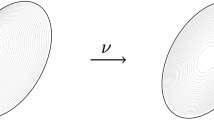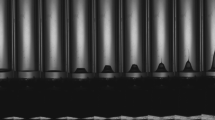Abstract
From Lagrange's equations of incompressible fluid motion a model is derived for the collision between a liquid mass and a solid surface. The classical idea of pressure impulse, P, is re-expressed as a quantity following the fluid-particle motion. It is shown that within this formulation P=0 is the exact free-surface boundary condition and the domain of definition of P is unambiguously time-independent. Some of the total kinetic energy of the fluid is lost during impact and this is associated with the usual choice of boundary condition for inelastic impact. With elastic impact, in which the fluid rebounds from the solid target, there is no kinetic energy loss. Some simple potentials are used to express P for incompressible fluid impacts, which have non-singular velocity fields: (i) in an acute wedge; (ii) in a cylindrical container; and (iii) in an idealised sea-wave impact. In the last the impact of a triangular fluid domain, T, illustrates kinetic energy loss from an impacting sea wave. Impact is also investigated for the collision of T with a movable solid block. The subsequent displacement of the block, with friction, is also calculated. Lastly a solution is obtained within T composed of a compressible fluid impacting a rigid wall. Standing compression-waves store within T some of the kinetic energy lost from the incident wave water.
Similar content being viewed by others
References
H. Lamb, Hydrodynamics. Cambridge: Cambridge Univ. Press, 6th edn.(1932) 738pp.
M.J. Cooker and D.H. Peregrine, Wave impact pressure and its effect upon bodies lyingon the sea bed. Coastal Eng. 18 (1992) 205–229.
M.J. Cooker and D.H. Peregrine,Pressure-impulse theory for liquid impact problems. J. Fluid Mech. 297 (1995) 193–214.
E-S. Chan, Mechanics of deep-water plunging-wave impacts on vertical structures. Coastal Eng. 22(1994) 115–133.
M.J. Cooker and J-M. Vanden-Broeck, Computations for a nonlinear theory offluid pressure impulse. Q. Jl. Mech. appl. Math. 54 (2001) 585–598.
A.A. Korobkin,Global characteristics of jet impact. J. Fluid Mech. 307 (1996) 63–84.
A.A. Korobkin and V. V. Pukhnachov, Initial stage of water impact. Ann. Rev. Fluid Mech. 20 (1988) 159–185.
S.G. Zhang, D.K.P. Yue and K. Tanizawa, Simulation of plunging wave impact on a vertical wall. J.Fluid Mech. 327 (1996) 221–254.
A.A. Korobkin and G.X. Wu, Impact on a floatingcircular cylinder. Proc. R. Soc. London A456 (2000) 2489–2514.
R.A. Bagnold, Interimreport on wave-pressure research. Proc. Inst. Civ. Eng. 12 (1939) 201–226.
D.J. Wood,Pressure-Impulse Impact Problems and Plunging Wave Jet Impact. PhD Thesis, University of Bristol (1997) 200pp.
D.J. Wood, D.H. Peregrine and T. Bruce, Wave impact on a wall using pressure-impulse theory. I.Trapped air. J. Waterway, Port, Coastal, Ocean Eng. Div. Proc ASCE. 126 (2000) 182–190.
G.X. Wu, Hydrodynamic impact force on a rigid body during impact with liquid. J. Fluids andStructures 12 (1998) 549–559.
Y-M. Scolan and A.A. Korobkin, The energy distributionfrom impact of a three-dimensional body. Submitted to J. Fluids and Structures (2001).
W.G. Szymczak, Energy losses in non-classical free-surface flows. In: J.R. Blake, J.M. Boulton-Stoneand N.H. Thomas (eds.), Bubble Dynamics and Interface Phenomena Dordrecht: Kluwer (1994) pp. 413–420.
J.C.W. Rogers and W.G. Szymczak, Computations of violent surface motions: comparisonswith theory and experiments. Phil. Trans. R. Soc. London A 355 (1997) 649–663.
E. Fontaine, B.Molin and R. Cointe, On energy arguments applied to the hydrodynamic impact force.(2001) Submitted to J. Fluid Mech.
A.A. Korobkin and D.H. Peregrine, The energy distributionresulting from an impact on a floating body. J.Fluid Mech. 417 (2000) 157–181.
M. Okamura, Impulsive pressure due to wave impact on an inclined plane wall. Fluid Dyn. Res. 12(1993) 215–228.
L.M. Milne-Thomson, Theoretical Hydrodynamics. London: Macmillan,5th edition (1968) 743pp.
L.S. Jacobsen, Impulsive hydrodynamics inside a cylindrical tank andof fluid surrounding a cylindrical pier. Bulletin Seism. Soc. Amer. 39 (1949) 189–204.
A.F. Whillock, Measurements of forces resulting from normal and oblique wave approaches to small-scalesea walls. Coast. Eng. 11 (1987) 297–308.
D.H. Peregrine, Water wave impact onwalls. Ann. Rev. Fluid Mechs. 35 (2003) 23–43. http://www.maths.bris.ac.uk/~madhp/preprints/impactreview.pdf
Y. Goda, Random Seas and Design ofMaritime Structures. Singapore: World Scientific (2000) 443pp.
S.J. Cox, Pressure ImpulsesCaused by Wave Impact. PhD Thesis, Faculty of Science, University of East Anglia (1998) 199pp.
T. Stevenson, Account of experiments upon the force of the waves of the Atlantic and German Oceans.Trans. R. Soc. Edinburgh 16 (1849) 23–32.
T. Stevenson, The Design and Construction ofHarbours. London: Black (1864) 189pp.
S. Hitachi, Case study of breakwater damages Mutsu-Ogawara Port. In: T. Takayama (ed.) Proc. Intl. Workshop on Wave Barriers in Deep Water. Port & Harbour Inst. of Japan, (1994) pp. 308–331.
L. Van Wijngaarden, Sound and shock waves inbubbly liquids. In: W. Lauterborn (ed.), Cavitation and Inhomogeneities in Underwater Acoustics. Springer Series in Electrophysics 4 (1980) 127–140.
I. Frankel, Compressible flow induced by thetransient motion of a wavemaker. J. Appl. Math. & Phy. ZAMP 41 (1990) 628–655.
Author information
Authors and Affiliations
Corresponding author
Rights and permissions
About this article
Cite this article
Cooker, M.J. Liquid impact, kinetic energy loss and compressibility: Lagrangian, Eulerian and acoustic viewpoints. Journal of Engineering Mathematics 44, 259–276 (2002). https://doi.org/10.1023/A:1020943222015
Issue Date:
DOI: https://doi.org/10.1023/A:1020943222015




